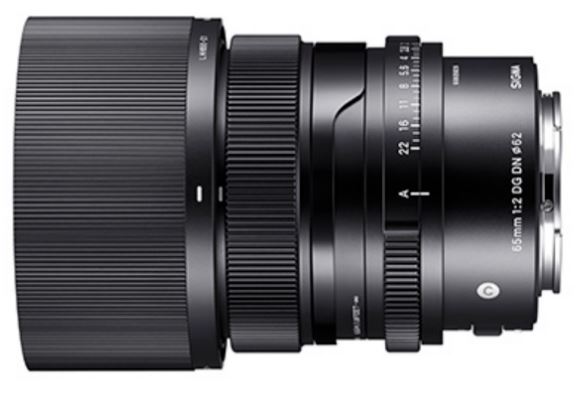
Sigma 65mm DG DN Lens for Sony
About Sigma
SIGMA is a manufacturer that creates and sells interchangeable lenses, digital cameras, and other photographic equipment. They have only made goods linked to photography and video since their founding in 1961. In other words, they are a business that exclusively develops photography-related technologies.
the ideal equipment for unique, unforgettable moments. Products and services that are ground-breaking, never-before-seen, and of the highest caliber are accessible anywhere in the world. SIGMA pursues innovation and exploration with unprecedented enthusiasm and dedication, guided by these unbounded principles as its objectives.

Instructions
Thank you very much for purchasing a Sigma Lens. To get the maximum performance and enjoyment out of your Sigma lens, please read this instruction booklet thoroughly before you start to use the lens.
WARNING!! : SAFETY PRECAUTIONS
- Do not look directly at the sun, through the lens. Doing so can cause damage to the eye or loss of eyesight.
- Do not leave the lens in direct sunlight without the lens cap attached, whether the lens is attached to the camera or not. This will prevent the lens from concentrating the sun’s rays, which may cause a fire.
- The shape of the mount is very complex. Please be careful when handling it so as not to cause injury.
DESCRIPTION OF THE PARTS (fig.1)
- Filter Attachment Thread
- Focus Ring
- Iris Ring
- Focus Mode Switch
- Mount
- Lens Hood
- Plastic Front Cap
- Metal Front Cap
ATTACHING TO THE CAMERA BODY
Please refer to the camera’s instruction manual for details on how to attach it to or detach it from the camera body.
- On the lens mount surface, there are electrical contacts. Please be careful with their handling as scratches or dirt on them could cause malfunctions or damage.
FOCUSING
For autofocus operation, set the focus mode switch on the lens to the “AF” position (fig.2). If you wish to focus manually, set the focus mode switch on the lens to the “MF” position (fig.3). You can adjust the focus by turning the focus ring.
- Please refer to the camera’s instruction manual for details on changing the camera’s focusing mode.
IRIS RING
It incorporates an iris ring that is useful for adjusting the aperture value during Aperture Priority Auto mode and Manual Exposure mode.
- With some cameras, the iris ring does not work.
- Check the camera’s instruction manual for how to adjust exposure.
FRONT CAP
In addition to the standard plastic front cap, a metal front cap is available for better integration.
- This metal front cap is attached to the lens using a magnet. Please do not put credit cards (magnetic cards) or any other objects close to the magnet on the metal front cap as it could corrupt any data held on the object.
- The metal front cap cannot be used with a filter. When using filters, please use the supplied plastic front cap.
LENS HOOD
A bayonet-type detachable hood is provided with the lens. This lens hood helps to prevent flare and ghost images caused by bright illumination from outside the picture area. Attach the hood and turn it clockwise until it stops rotation (fig.4).
- To place the lens and hood into the storage case, you must first remove the hood, and then replace it with the lens in the reverse position (fig.5).
BASIC CARE AND STORAGE
- Avoid any shocks or exposure to extreme high or low temperatures or humidity.
- For extended storage, choose a cool and dry place, preferably with good ventilation. To avoid damage to the lens coating, keep away from mothballs or naphthalene gas.
- Do not use thinner, benzine, or other organic cleaning agents to remove dirt or fingerprints from the lens elements. Clean by using a soft, moistened lens cloth or lens tissue.
- This lens is not waterproof. When you use the lens in the rain or near water, keep it from getting wet. It is often impractical to repair the internal mechanism, lens elements, and electric components damaged by water.
- Sudden temperature changes may cause condensation or fog to appear on the surface of the lens. When entering a warm room from the cold outdoors, it is advisable to keep the lens in the case until the temperature of the lens approaches room temperature.
TECHNICAL SPECIFICATIONS

- Dimensions and weight include the L-Mount.
- The glass materials used in the lens do not contain environmentally hazardous lead and arsenic.
www.sigma-photo.co.jp/support/contact/
info@sigma-photo.co.jp
Telephone: (044) 989-7430
FAX: (044) 989-7451
www.sigma-global.com/
SIGMA CORPORATION
2-4-16 Kurigi, Asao-ku, Kawasaki-shi, Kanagawa 215-8530 Japan
PHONE : 044-989-7430 FAX : 044-989-7451
FAQS About Sigma 65mm DG DN Lens for Sony
What is the Sigma 65mm’s shortest focus distance?
55cm
Why is a 65mm lens useful?
generates a broad, spherical bokeh.
What is a 65mm lens’ field of view?
68° angle
What is a 65mm lens’ field of view?
It gives a field of vision that is 8 degrees broader than an 85mm lens (37 vs. 29 degrees).
Is a 65mm lens regarded as a standard lens?
Additionally, focal lengths between 40 and 58mm are regarded as normal.
Is 65 mm suitable for portraiture?
It would work well for headshots and perhaps environmental photographs.
What distinguishes Sigma’s DC and DG lenses?
DC informs you that the lens is for a crop sensor camera whereas DG indicates a lens made for a full frame camera.
Why do Sigma lenses have the designation DG DN?
DG – Although these lenses were made particularly for full-frame DSLRs, they also function with crop sensor systems. DN – Lenses bearing this designation are made especially for small-sensor cameras, including micro-four-thirds.
How far can the attention be focused?
From a distance of 0.7 m and beyond, focus is acceptable.
For more manuals by Sigma, Visit Manualsdock
[embeddoc url=”https://manualsdock.com/wp-content/uploads/2023/09/Sigma-65mm-DG-DN-Lens-for-Sony-Instruction-Manual.pdf” download=”all”]



